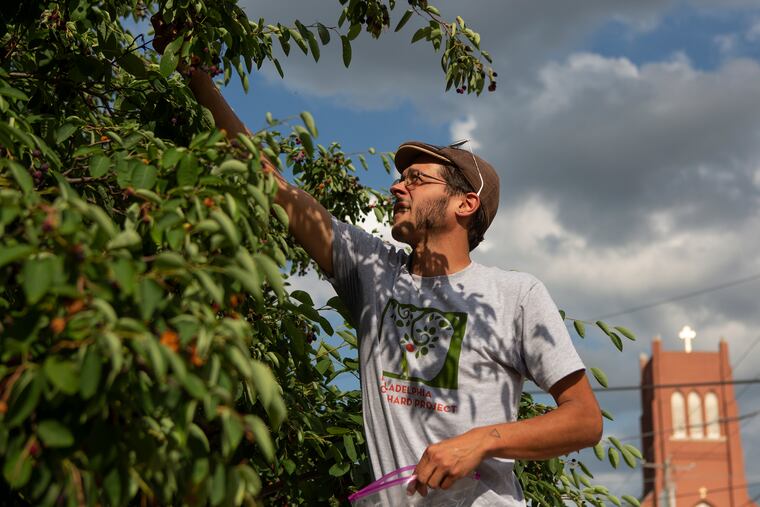Behold the juneberry, Philly’s sweetest secret, and the harvesters who pluck them from the sidewalks | Mike Newall
The real pleasure of the juneberry harvest is the way a hidden layer of the city ripens before you.

I have lived in Passyunk for two years, and it’s never occurred to me to pluck a ripe juneberry from the bushes all around the neighborhood, never mind eat one. City folk don’t tend to think like that.
But one night this week, as the happy hour crowds were sipping craft brews in the heat, and shoppers were hefting bags full of processed and plastic-wrapped foods from the Acme, I found myself watching a small number of people scaling trees in the garden of the South Philly Older Adult Center in search of the unassuming little fruit that, for them, marks the beginning of summer.
I was hanging out with members of the Philadelphia Orchard Project, a group of gardeners dedicated to planting long-term, sustainable orchards in a city with so many barriers to healthy food. They plant in vacant lots, community gardens, and school yards.
They have an orchard in Bartram’s Garden, and one near an abandoned Tastykake factory in North Philly. In Strawberry Mansion, they operate an orchard with neighborhood residents, in a spot where kitchen gardens grew 200 years ago. They’re headquartered at the Woodlands estate in West Philadelphia.
>> READ MORE: Finding edible ingredients growing right in the backyard
Since 2007, they have planted and helped maintain 64 community orchards. And these aren’t just flower beds. They’re whole ecosystems with fruit trees, pollinator gardens, and medicinal plants. Things that grow and last.
“It’s an orchard that can be a permanent fixture in the neighborhood and community, and allow those benefits to accrue over time,” said Kim Jordan, the group’s development director.
But back to the juneberries. Think of them as a cross between a cherry and a blueberry, with a nutty finish. They are native to Philadelphia and are many people’s first experience with the Orchard Project harvesters. (You might also see them in the mulberry trees, whose harvest is up next this weekend, followed by wineberries, gingkos, and crab apples.)
You’re probably within spitting distance of a juneberry tree on any given block in the city. They’ve been cracking through the cobblestones here for centuries.
Years ago, they were called shadberries, because their ripening signaled the schools of fat shad that would swim down the Delaware. Now, the city plants juneberry bushes along I-95.
The harvests are the best way to engage people, Jordan said. Passersby might raise eyebrows at a group of growers eating berries straight off the bushes near the Spring Garden El stop, but some are curious and linger. “We want people to find us,” she said. “[At the Spring Garden stop], everyone was very suspicious. Can you eat those? Are they safe?”
Take Trinh Loy, who cuts through the senior center garden on her way to the Acme and was at first mystified by the harvesters. Now she makes jam every year out of juneberries.
And then there’s Bob Jobin, a master gardener from the neighborhood whose passion for juneberries was evident by the swell of the Ziploc bag he collects them in. “At this time of year, it’s like a buffet as you walk down the street,” he said. “You have a hard time getting them in the bag and keeping them from your mouth.” (So does Olive, his bluetick beagle, who eats them off the sidewalk.)
>> READ MORE: 5 edible plants you can forage for in your backyard, and how to cook them
It is hard not to be charmed by the orchard folks. And the berries are good. I ate several. But the real pleasure of the harvest is the way a hidden layer of the city blooms before you — the secret knowledge that, yes, you can eat that little berry growing next to the El. That there are green and growing things here to be more than just admired — but to be taken advantage of, for food and comfort and life.
When Jordan moved here in 2004 to get her Ph.D. in immunology at the University of Pennsylvania, she almost didn’t want to stay. But planting trees and plucking juneberries in neighborhoods across the city — and meeting the people who cared about them — made the city feel like home. Now she works full time for the Orchard Project.
“It’s incredible to know that I am helping make a tiny little corner of the city a bit more beautiful and healthy and peaceful,” she said.
Back on Passyunk Avenue, the harvesters kept at it. In just a few days, the juneberries will ripen and fall.